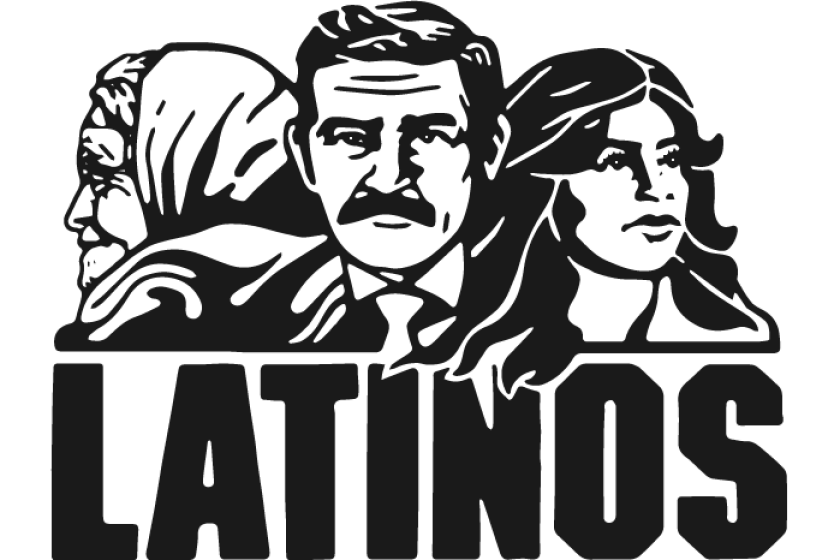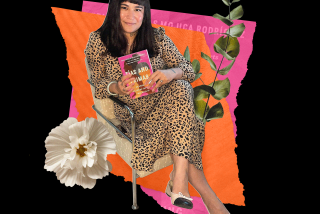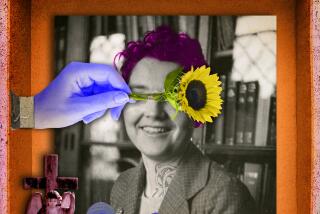Chicano writers: A new energy
Lorna Dee Cervantes, 28, reared in the poverty of what she calls the welfare class of San Jose, said her writing career began one Christmas morning when she found the works of Stevenson, Byron and other English poets at the bottom of a box filled with secondhand toys.
These poems came to Cervantes in her sal si puedes (get out if you can) barrio as one of the most important events in her life: the elegant English that she learned to read and write.
But she has another voice—a Chicano poverty imbued with inflections richly Californian. This voice comes for her Santa Barbara family of Indians and Californios on her mother’s side, and from the Tarascan ancestry of her Mexican father’s side.
You can hear it in her kinship with hawk, crow and mockingbird, mythic beings that tie her to the Indians of California and Mexico, a vision of the West new to most readers.
And in her book of poems, “Emplumada” (“In Plumage”), she shows not only a strong, Chicana matriarch struggling in poverty without men, but a painful awareness of being empowered to speak for a people.
I’m marked by the color of my skin.The bullets are discrete and designed to kill slowly.
They are aiming at my children.
These are facts.
Let me show you my wounds:
my stumbling mind, my “excuse me” tongue.
There are dozens more Chicanos like Cervantes who are writing second or third novels, working on a fourth or fifth volume of poetry, all of them increasing a literature that is still young.
To Yale scholar Juan D. Bruce-Novoa, these writers will fundamentally change American letters with contributions comparable in depth to those made by American Jewish writers in the ‘20s and ‘30s and black writers in the ‘40s and ‘50s.
But readers don’t have to wait 10 to 20 years to see results. “I think we are at point,” Bruce-Novoa said, “where Chicano writers are already having an impact, where mainstream critics and editors recognize this new energy.”
And this energy is multiple. In recent years, Chicano writers of fiction and poetry have chalked up major national and international prizes. Together with black and Native American poets, they have reminded some of today’s Anglo poets of the oral roots of poetry.
Just as important, Chicano writers have rescued Spanish as a literary language in the United States.
Novelist Rolando Hinojosa, winner of Cuba’s Casa de las Americas fiction prize for his novel, “Klail City y Sus Alrededores,” can take some of the credit for this. Hinojosa’s feat has been to write marvelous orchestrations of the ironic and understated Spanish spoken by the Mexicans of south Texas.
Alejandro Morales of UC Irvine can also share the credit. His novels, “Cara Viejas y Vino Nuevo” (1975) and “Verdad Sin Voz” (1978), published by Mexico’s prestigious Joaquin Mortiz, were the first Chicano works written for a Mexican audience.
And his latest novel, “El Reto en el Paraiso,” published this year by Bilingual Press, is perhaps the first truly bilingual novel because his characters speak in three distinct modes—Spanish, English or a Chicano blend of the two.
Hinojosa and Morales, among others, have also had a role in inspiring Anglo writers to consider the language of Miguel de Cervantes and Pablo Neruda.
Jim Sagel of New Mexico, author of a short-story collection entitled “Tunomas, Honey” and winner of the 1981 Casa de Las Americas short-story prize, said Spanish is the only language that can capture the life of the viejitos (old-timers) of northern New Mexico.
Despite economic hardships that have forced many Chicano small presses to fold, Chicano publishing has still grown at a modest rate while Anglo small-press publishers have demonstrated more interest in Chicano works. This year promises to be particularly fruitful for Chicano literature, with more than 25 new works of fiction and poetry scheduled for release.
Some examples are Nash Candelaria’s “Not by the Sword,” a historical novel of the U.S. conquest of New Mexico, published by Bilingual Press and winner of the Before Columbus Foundation’s American Book Award, and Ricardo Martinez’s “Ritual Healing,” a medical mystery novel to be released by Tonatiuh International.
Small Chicano publishers have survived by carving a niche for themselves in American and European universities. Some Chicano publishers sell as many as a third of their books in Europe, particularly to West and East German university students enrolled in American studies courses.
“When the Europeans look to the Southwest, they turn to Chicano writers because they consider them part of American literature, just like Faulkner, whom they consider a Southern writer,” said Juan Rodriguez, co-owner of Relampago Books of Texas, a full-time distributor of Chicano literature.
University houses such as Pittsburgh Press have joined the ranks of traditional publishers of Chicano authors, like Notre Dame Press, complementing the work of Chicano studies programs to teach this literature as a serious academic subject.
One element that distinguishes Chicano writers, given that Chicano literature is thoroughly eclectic in style and subject, is the unmistakable influence of the Spanish language and Mexican culture.
This influence shows in the distinct musicality, rhythm and emotional qualities of Chicano writers, whether in English, Spanish or Calo, a highly developed slang with roots in the 16th-Century Spanish, American Indian languages, English and unabashed invention.
Some of the most celebrated Chicano works have been written in Spanish and Calo. This is quite miraculous, considering that the conquest of what was once northern Mexico occurred more than 130 years ago.
Then there is that special realm of those who write in a blend of Spanish and English.
Perhaps the consummate bricoleur of Spanish and English is poet and Sacra veteran (Sacramento veteran) Jose Montoya. According to Bruce-Novoa, Montoya best illustrates in his poem to a memorable dude, “El Louie,” how Chicano writers meld two languages into a new structure:
Ese Louie . . .
Chale, call me “Diamonds,” man!
Y en Korea fue soldado delevita con huevos and all the
paradoxes del soldado raso—heroism and the stockade!
“We never switch completely (from one language to another) because we are working with a new language that has incorporated elements from both,” said Bruce-Novoa, who is originally from Colorado. This phenomenon, he said, must be understood as interlingual instead of bilingual.
The clearest example of this on a mass level, he said, is the linguistic cross-fertilization that takes place along the U.S.-Mexican border.
Interlingualism, however, is not unique to the border states. To varying degrees, interlingualism is a two-way street in which cultural and economic forces modify both Spanish and English wherever the United States and Latin American come in contact, he said.
Chicano writers, he said, reflect this dual process by translating Spanish literary influences into English and vice versa, reminiscent in some ways to the development of early 16th-Century Spanish poets.
“We find the same awkwardness when the Spansih poets began using Italian Renaissance forms, until Garcilasco de la Vega came along and made it all work,” thus beginning Spain’s Siglo de Oro (the Golden Age), Bruce-Novoa said.
However it is defined, Alurista said he writes in English and Spanish because it accurately reflects Chicano speech. Alurista, considered the first Chicano poet to use this technique, said the violent juxtaposition of Spanish and English is intended to reflect the tensions that exist between Chicanos and Anglo Americans.
However, his work does pose problems for other than bilingual audiences.
In Alurista’s view, any incomprehension is the result of an unequal cultural and political melting pot that has favored English almost to the exclusion of other American languages. The long-term effect, he said, is that mainstream publishers do not see a market for bilingual works because of what he regards as a longstanding linguistic xenophobia.
“But one of the things you must understand about Chicano writers: We are trying to develop our own forms.” And as a result, he said, “Our work is inevitably labeled experimental. Major publishers say, ‘That’s too experimental; it hasn’t jelled into a style yet.’
“We are experimenting, there’s no question about that. But one must not mistake experimental work for non-proficient work. Anyway, maturity for us would be ossification, the paralysis of saying we have found our form.”
Whether Alurista’s view of publishing in the United States is accurate, the insistence of many Chicano writers not to compromise their values led to the establishment of independent Chicano publishers. For Alurista, this is where the real future of Chicano literature is being written.
And the 35-year-old poet practices what he preaches. Alurista publishes Maize, a literary magazine; books of poetry; novels, and a recently released anthology of United States-Mexican border literature, Literatura Fronteriza: Antologia del Primer Festival San Diego-Tijuana, composed of poetry and short stories written by Chicanos, Anglos and Mexicans.
“Maybe 50 years from now (the major publishers will accept bilingual Chicano writers); it just depends how tapados (backward) they are. How long did it take for jazz to be accepted into the mainstream of American music? Jazz had existed 75 years before white audiences realized they could pick up on it.”
::
Novelist Ron Arias responds to Alurista’s argument by repeating one of his grandmother’s favorite refrains, “Maiz como mueles (Corn how you grind).”
“The audience is hungry for something good,” Arias said. “I disagree with Chicano writers who say the majority audience will not read us because of racial or cultural barriers. That has very little to do with it. It’s because a lot of out work has been mediocre.”
The 44-year-old writer first worked as a journalist in Latin America, where he was influenced by such storytellers and poets as Jorge Luis Borges, Pablo Neruda and Roberto Juaroz. His novel, “The Long Road to Tamazunchale,” a 1976 National Book Award nominee, recounts in a magic realist style an older Chicano’s imaginative way of facing death.
He said that 10 years ago a lot of very poor writing was published by small presses because political and cultural awareness among Chicanos was so strong.
Now, he said, as more Chicano writers master English and Spanish, they have an opportunity to become translators of Chicano and, by extension, Latin American reality for U.S. readers.
But, Arias added, Chicanos are Americans, “as much as or more than any American group. Except that we have an indigenous strain. And some Latinos have an African strain. And that’s what makes us unique,” he said, because “most Americans only have a European strain.”
Surprisingly, what qualifies Chicano writers as cultural translators are these same typically American traits. He said the Chicano’s mestizaje (blending) of indigenous, Spanish and Anglo roots is one of the best expressions of the American melting pot.
The pot he refers to, however, is not in the United States, but Latin America, where Africans, Indians and Europeans have mixed their blood and cultures to a greater degree to create a new breed of people. Despite the differences, Arias said this mixture of Old and New World cultures is what unites all the Americas.
A Chicano Reading List
This reading list is a small sampling of Chicano literature since 1978.
Inquisitive readers, however, can turn to several critical works on Chicano literature, such as Bruce-Novoa’s “Chicano Authors: Inquiry by Interview,” which can serve as guides to the hundreds of works published since the 1960s.
—Rudolfo Anaya, “The Silence of the Llano,” short stories, Tonatiuh International, Berkeley, 1983.
—Nash Candelaria, “Not by the Sword,” novel, Bilingual Press, Ypsilanti, Mich., 1983.
—Alejandro Murguia, “Farewell to the Coast,” short stories, Heirs Press, San Francisco, 1980.
—Luis Omar Salinas, “Darkness Under the Trees,” University of California Chicano Studies Publications, Berkeley, 1982.
—Ricardo Sanchez, “Amsterdam Cantos y Poemas Pistos,” poetry, Arte Publico Press, Austin, Tex., 1983.
—Rolando Hinojosa, “The Valley,” novel, Bilingual Press, Ypsilanti, Mich., 1983.
—Jim Sagel, “Tunomas, Honey,” short stories, bilingual edition, Bilingual Press, Ypsilanti, Mich., 1983.
This story appeared in print before the digital era and was later added to our digital archive.
More to Read
Sign up for Essential California
The most important California stories and recommendations in your inbox every morning.
You may occasionally receive promotional content from the Los Angeles Times.











